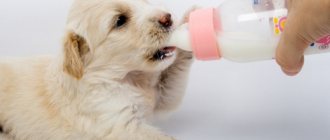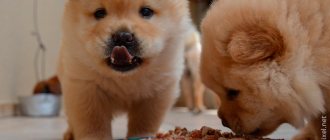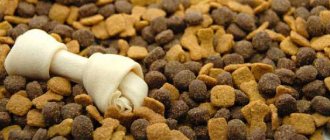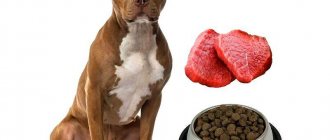Has a cheerful, funny, fluffy puppy appeared in the house? Are you thinking about proper care, bathing, walking? A loving owner takes care of every detail. We will have to solve an equally important problem - feeding the pet. The daily diet determines the baby’s health, appearance, smoothness of coat, strong teeth, activity, and cheerfulness. You can’t ignore the menu, so let’s look at the question “how to feed a puppy correctly.”
Experienced dog breeders understand the importance of selecting the right nutrition for their furry family member, providing them with the necessary microelements. And for those new to dog training, it’s not easy to understand the intricacies of the matter. What can you feed a puppy, what food to choose, whether it is necessary to mix natural food - there are many questions in the head of the new owner. Let's figure it out in order.
Features of puppy development at 3 months
The developmental characteristics of a puppy at 3 months may vary slightly depending on the breed. However, almost all puppies between 3 and 6 months of age are in the active growth stage. A constantly growing body, the need for communication, activity and acquiring new skills creates increased energy needs.
A balanced diet is one of the key factors in the timely development of a puppy, both physically and mentally. At the age of 3 months, the pet’s body begins to prepare for the replacement of baby teeth, which leads to an increased need for vitamins and microelements. In addition, before the replacement of baby teeth, the puppy’s immune defense is sharply reduced . During the period of feeding with mother's milk, the puppy receives not only nutrition, but also antibodies that protect it until the age of three months.
At the age of 2 months or slightly older, your pet should be vaccinated. 2 weeks before vaccination it is necessary to carry out parasite prevention. Before preparing for vaccination, you must visit a veterinarian, since vaccinations can only be given to an absolutely healthy animal. If the doctor finds that the pet is suffering from any ailment, treatment is carried out first, and after vaccination.
The benefits and harms of cereals
Conventionally, dog food is divided into 2 types: industrially produced and homemade. Both options have both pros and cons. Proponents of home cooking for dogs highlight several compelling arguments in its favor:
- Fast weight gain. Properly prepared natural food for dogs promotes the growth of missing muscle mass, without the risk of obesity. But this does not mean that the animal can be fed exclusively carbohydrates. It is necessary to cook porridge for your pet in certain proportions. In addition to maintaining a balance of cereals and protein, you need to additionally provide a complex of vitamins and minerals.
Expert opinion
Anna Abramenko
An avid dog lover. Experience in veterinary medicine since 2009.
Ask a Question
Weight loss in an animal may be due to health problems or parasites. Consultation with a veterinarian is necessary to rule out these possibilities.
- Improving the condition of the coat. With a balanced diet, which includes various types of cereals, the quality of dogs' hair and teeth significantly improves. Thanks to carbohydrates, their coat acquires shine and a uniform structure.
- Energy charge. Owners of different breeds note that if you give porridge to dogs, they become more active and cope better with physical activity. Some types of cereals are rich in vitamins and microelements necessary for the full development of the animal. Balanced cereals are a source of carbohydrates, many of them contain protein. This unique composition provides the dog’s body with the necessary energy.
- Natural colon cleansing. Included in most cereals, fiber normalizes the functions of the large intestine. By adding several types of cereals to the diet, the functioning of the dog’s digestive system significantly improves.
Despite the abundance of positive actions, giving an animal exclusively plant food is unacceptable. High-quality food prepared at home should contain amino acids and a significant amount of protein. Therefore, in addition to cereals, recipes for various porridges contain meat, offal and sea fish.
Expert opinion
Anna Abramenko
An avid dog lover. Experience in veterinary medicine since 2009.
Ask a Question
The statement about the dangers of plant components is only partly true. Some types of cereals are really not suitable for dogs. Their health is also negatively affected by the low meat content in prepared food and individual intolerance to some type of cereal. In any case, if you notice a deterioration in the dog’s condition after eating porridge, the diet needs to be reconsidered.
Dry food for a puppy at 3 months
Most owners prefer to feed their pet dry food because it is convenient and saves time. However, at three months of age, a puppy is not ready to eat dry granules and there are a number of good reasons for this. The puppy's digestive tract adapts to digesting new food gradually. Dry granules entering the digestive tract actively absorb water. At such a young age, feeding dry food can lead to dehydration, even with active drinking of water.
Dry food can be introduced into a puppy’s diet only in a soaked form. To prevent the granules from harming the pet’s body, they must be filled with warm water or broth 10–15 minutes before feeding. After the granules are saturated with water, increase in volume and become soft, they must be crushed and mixed with canned food. For large breed puppies, soaked dry food can be introduced into the diet from 3 months, for others not earlier than 4 months.
The best cereal recipes to give to puppies
Rice porridge with meat and vegetables
Take 500 g of beef (can be replaced with veal heart), place in a saucepan and cook for 30-40 minutes. Meanwhile, finely chop the zucchini, carrots, onion and parsley. Remove the cooked meat from the pan and chop into small pieces. Cook the rice in the resulting broth (at the rate of 100 g of cereal per 350-400 ml of water), then mix it with the rest of the ingredients and let it brew for 10-20 minutes.
Buckwheat porridge with stewed vegetables
Good for well-fed puppies who need to “lose weight.” Soak 200 g of cereal for 15-25 minutes, then place in a saucepan, add 450 ml of cold water and cook until the liquid evaporates. In another bowl, simmer vegetables (carrots, cabbage, onions and beets), seasoning them with butter. Bring to readiness, transfer to a container with buckwheat and stir.
Oatmeal (for small puppies, the grains need to be ground)
Steam the cereal with hot water or low-fat meat broth. Then place in a warm place and leave for 20-30 minutes, stirring occasionally. Use on the day of preparation.
Canned food
Commercial canned dog food comes in the form of pates and kibbles with gravy. The pates are suitable for feeding a puppy aged 1 to 2 months. Afterwards, the pet can be transferred to canned food so that it learns to chew and consume food similar to porridge.
While feeding canned food, it is important not to forget that the basis of the diet should be milk. If you are following a commercial diet, your puppy can only be given a bitch milk replacer, which is sold in powder form and diluted with water. To prevent your puppy from developing dehydration, you need to make sure that he drinks enough water.
The key factor when choosing a canned commercial food for your puppy is quality. Traditionally, feed is divided into four classes. For daily feeding of puppies, premium food and higher are suitable. Economy class food does not contain enough proteins, vitamins, but contains preservatives, flavor enhancers and useless fillers.
How much food should you give your puppy?
With a natural diet, the daily amount of food consumed by the dog should be approximately 6-8% of the dog's weight. For example, if your pet weighs 10 kilograms, then 7% would be 700 grams.
Feeding a puppy correctly does not mean feeding it to its fullest. Overfeeding is much worse than underfeeding.
You must determine the serving quantity yourself, based on your age and level of physical activity. Appetite can be influenced by many factors. For example, in the summer, when it’s hot, dogs eat much less than in the cold season. Read about what to do if your pet is not eating well.
Knowing whether your puppy is hungry or not is very simple. If the baby licks the bowl after feeding without leaving anything there, this means that the fluffy is not full. In this case, you should increase the portion. Well, if the baby leaves excess porridge in the bowl, then he is completely full.
Natural food for a three month old puppy
Natural food is considered more natural for feeding dogs. At three months of age, a puppy is able to digest almost the entire range of natural products approved for feeding dogs.
The diet should be based on protein foods:
- Milk, homemade fermented milk products, including cottage cheese.
- Boiled meat or after long-term freezing - beef, veal, rabbit, chicken, turkey; if you are not overweight, you can use duck.
- Meat by-products, cleaned and boiled – heart, lungs, udder, beef liver. You can use ground beef tripe raw.
- Chicken and quail eggs, boiled and raw.
- Sources of carbohydrates are rice, buckwheat, barley flour. If you are underweight and have no allergies, you can have wheat cereal. If you are at risk of gaining excess weight, you can use pearl barley.
- Sources of hard fibers are carrots, cucumbers, zucchini, pumpkin, boiled cabbage, raw potatoes, etc.
- Sources of vitamins are not too sweet and juicy fruits and greens.
At three months of age, you can prepare porridge for the puppy or give food separately. To prepare complex meals, you can use simple recipes. For example, you can make an omelet from eggs and milk, which is fried in a dry frying pan. By mixing cottage cheese and carrots, you will get food for your pet rich in calcium, proteins and vitamins.
List of healthy and harmful foods
products that benefit a young body:
- Lean varieties of meat, fish and poultry;
- Meat and fish by-products;
- Fresh vegetables and fruits;
- Sour cream, kefir, cottage cheese, whey and other fermented milk products without flavoring additives and sugar;
- Porridge.
Don't be afraid of the apparent scarcity of your pet's menu. A dog by nature is a predator, so its diet consists mainly of protein foods.
Veterinarians include the following in the category of prohibited
- Candies, cookies, sweets. They contain glucose, which starts fermentation processes. For predators, they have a negative impact on the state of the digestive system;
- Spicy, salty dishes, as well as food with a lot of spices;
- Tubular bones. When chewed, they crumble into many small fragments that can cause intestinal obstruction and injury to the esophagus;
- Pork. It is a source of trichinosis, which is difficult to treat and painful for the dog;
- Whole milk. The pet's body is not able to absorb it;
- Cabbage and various types of legumes provoke fermentation processes;
- River fish, which becomes a source of helminthic infestation;
- Sausages containing a large amount of harmful impurities, dyes and preservatives.
- Boiled potatoes, which are not digestible in the puppy's digestive system.
By refusing to use harmful ingredients in your four-legged pet's diet, you will maintain his health, strengthen the immune system and raise a healthy dog.
Mixed feeding - what is it?
Some owners prefer mixed feeding, that is, keeping the pet simultaneously on industrial and natural food.
Feed manufacturers and veterinarians do not recommend this type of feeding, although the experience of many owners suggests otherwise.
From a theoretical point of view, the dog's gastrointestinal tract is not able to adapt to the digestion of natural and industrial products that the dog consumes at the same time.
It is important to understand that natural food enters the intestines and begins to be digested 10–20 minutes after eating. Dry food needs 20–40 minutes to gain moisture and drop into the intestines. It turns out that when feeding dry granules and natural products at the same time, some of the food is simply not digested. This problem can be solved by pre-soaking the dry food.
Feeding regimen for a puppy at 3 months
At three months of age, the puppy receives its first vaccination, after which it can be walked outside. For many owners, this event becomes a holiday, since the pet can be trained to use the toilet outside the home. Feeding schedule is extremely important at three months of age, as you will be able to track caloric intake and the time after which the pet needs to be taken outside.
The frequency of feeding a puppy at 3 months of age is individual and ranges from 3 to 5 meals per day. The smaller the dog, the more often it should eat. Intentionally increasing the portion of food when the puppy is not ready for this leads to overdistension of the stomach, which can lead to overeating and excess weight gain in the future.
Does nutrition depend on the breed?
Puppies of dogs of different breeds have different metabolisms in the body. Small breed pets have a faster metabolism than large dogs.
Nutrition for large breed puppies
Puppies feed on mother's milk until 25 days of life. The dog needs to be fed several times a day. It’s good if there is a lot of milk, but in any case, puppies should be fed meat food 2 times a day and given milk 4 times. For a one-month-old puppy, the meat norm is 100 grams.
- MMM tasty!..
By 1.5 months, feeding small pets becomes the sole responsibility of the breeder. During the day there should be six meals - three meat portions and three dairy portions. Meat is given 150 grams per day.
Nutrition for medium breed puppies
Kids of medium breeds develop faster than their larger counterparts. At the age of 6 weeks, puppies are fed 5 times a day: 3 times a meat portion and 2 times a milk portion. The daily amount of meat is 100 grams. Two-month-old puppies are fed four times a day. The amount of meat is increased to 200 g per day.
Nutrition for small breed puppies
Until 8 weeks of age, small breed puppies are fed 5 times a day. From two months, babies are transferred to 4 meals a day, their meat portion is 150-200 g of meat.
Water in a puppy's diet at 3 months
Water is the basis of blood and all body fluids. With a lack of water, the blood in puppies thickens, which leads to harmful consequences. In puppies at three months of age, dehydration develops rapidly and can cause irreparable harm.
Important! Dehydration is one of the key reasons why it is not recommended to feed dry food pellets to puppies at three months of age.
Typically, puppies do not have problems drinking water if a drinking bowl is readily available. When choosing a commercial diet, make sure that your pet has at least two large drinking bowls freely available to him. The water needs to be changed once a day, more often in hot weather. The higher the air temperature, the faster pathogenic microflora develops in the water, and this is fraught with indigestion and disruption of the gastrointestinal tract.
How often?
- 2-3 months: fed six times a day: every three hours, starting at about seven in the morning and ending at nine to ten in the evening.
- 2-4 months: four to five times a day, increasing the interval between feedings.
- 4-6 months: three to four times a day, every five to six hours.
- 6-10 months: three times a day, every six to seven hours.
- older: twice a day, morning and evening, like adult dogs.
At 1-2 months, meat or fish is given once a day; twice - porridge with water, meat or vegetable broth, with the addition of vegetables and meat; once - milk, cottage cheese or kefir; the remaining two times you can give dairy products or oatmeal cooked in milk.
The time of one feeding is about 15-20 minutes. If there is any food left in the bowl after this, it should be removed.
IMPORTANT ! Before giving your puppy physical activity, you must wait 1-2 hours after eating. Excessive activity on a full stomach can seriously harm your pet's health.
It is also useful to install a stand for bowls at the level of the puppy's chest: you can make it yourself or buy it. The tripod stand will last a long time because it allows you to adjust the height as the animal grows.
Vitamins and supplements
Until the puppy leaves the active growth phase, he constantly needs vitamins and supplements with microelements. If you keep your pet on a commercial diet, its needs for vitamins and minerals can be compensated with the help of high-quality food of super premium class or higher. When feeding premium food or a natural diet, vitamin supplements must be added to the puppy’s diet.
What cereals can you feed your dog?
Not all grains are recommended for dogs as food on an ongoing basis. Some should be treated with caution, due to possible allergic reactions or individual intolerance.
- Rice porridge is suitable for daily consumption by all breeds of dogs. It contains vitamins E and group B, as well as zinc, iron, magnesium, and potassium. In addition to the undoubted benefits of microelements, rice has an absorbent effect. Its decoction will help with a dog's stomach upset, diarrhea and poisoning.
Expert opinion
Anna Abramenko
An avid dog lover. Experience in veterinary medicine since 2009.
Ask a Question
Preference should be given to unpolished types of rice; they contain more protein and lipids. This type of cereal contains less starch and is easier to digest, it does not contain gluten, and it is considered hypoallergenic.
Excessive consumption of rice cereal by a dog can cause constipation. You can avoid this by combining several cereals.
- Buckwheat porridge is rich in iron and magnesium, vitamins B and E and other microelements. It is easily digestible and suitable for large breeds or sedentary dogs. Regular consumption of buckwheat speeds up metabolism and strengthens the immune system. For animals with problems with the cardiovascular system, it is necessary to introduce it into the diet. This porridge is recommended to be given to puppies and pregnant dogs.
- Wheat porridge is considered a natural scrub for the intestines. Due to incompletely digested particles, it removes food debris from the walls. The starch content makes it contraindicated for dogs prone to gaining excess weight.
- Yachka combines high nutritional content and economical efficiency. Barley contains silicon and fluorine. But the amount of microelements is low, insufficient for complete nutrition of a healthy dog. Yachka is not suitable for the daily diet.
- Oatmeal often causes allergic reactions, so it should be administered with caution. It is recommended to start feeding your dog oatmeal with small portions and carefully monitor its condition. The reaction is expressed in intense scratching of various parts of the body, redness and rashes. You should also use oats, not rolled oats.
When preparing natural food, it is recommended to mix different types of cereals. This will expand the list of vitamins and microelements in their composition. You should not give preference to any one of the porridges; a dog’s complete diet requires variety.
?
What should you not feed a puppy at 3 months old?
Let's figure out what you shouldn't feed a puppy at 3 months. Most prohibited foods should not be given to dogs even at an older age, since they are toxic or pose a direct threat to life. Prohibited foods for a 3 month old puppy:
- Tubular bones, skin, pure fat.
- Baked goods, bread, pasta and other products containing flour.
- Chocolate, candy, cookies and other products containing sugar, sweeteners, sugar substitutes, caffeine, xylitol, cocoa.
- Sausage products, hard cheeses of dubious quality and any products containing vinegar, marinades, spices, smoked products, salt.
- Leftovers from the table.
- Boiled potatoes are a pure source of starch.
- Raw cabbage causes flatulence.
- Onions and garlic are toxic to dogs.
- Semolina porridge with milk is the most common cause of acquired diabetes mellitus in dogs.
Products of questionable usefulness for a puppy’s diet at 3 months:
- Pork is considered too fatty meat and can serve as a source of infection with worms or the wet rabies virus. Lean pork after heat treatment is a dietary meat that can be given to a puppy.
- Raw fish and seafood are rich sources of microelements and proteins, but they can expose your dog to dangerous elements.
- Whole milk – Some dogs develop lactose intolerance after weaning.
- Honey is a very healthy product, but a strong allergen.
- Raw eggs can cause allergies.
- Grapes and raisins are toxic in large quantities.
- Raw and boiled liver - can lead to diarrhea and constipation (respectively).
- Mushrooms are practically not digestible and can cause indigestion.
- Beans and corn are practically not digestible.
- Soy is a strong allergen.
- Nuts - can lead to an allergic reaction and even anaphylactic shock.
- Juicy fruits can cause diarrhea.
- Spongy bones are a source of calcium, an excellent toy, but if they swallow splinters or get stuck in the teeth, they are a mortal danger.
Important! Products of questionable usefulness are not prohibited, that is, they can be given if precautions are taken and if no negative consequences are observed after eating.
What foods are forbidden to give to a puppy and add to porridge?
Poor or unhealthy nutrition almost always leads to illness. The list of foods that are prohibited for dogs includes:
· Cow's milk - if the puppy is lactose intolerant.
· Corn grits - the pet’s body does not absorb it. Barley and semolina have been removed from the diet due to the risk of allergic reactions. Millet contains monosaccharides, mineral compounds, fiber and starch. Such a rich composition is difficult for the puppy’s gastrointestinal tract and often causes intestinal volvulus.
· Pork is a fatty meat that can cause indigestion. It may contain parasites and viruses of Aueszky's disease, to which dogs are susceptible. Forget about freshwater fish, which are very often infected with worms.
· Bones. Only small fresh moslaks are acceptable. The remaining parts may contain cracks and sharp edges, damaging the stomach and leading to gastritis, ulcers and tumors.
· Sweets, flour, sugar, smoked products, sausages, spices, herbs are the strictest taboo and poison that can cause irreversible liver damage. Mushrooms, pasta, beans, peas and white soft bread are prohibited.











